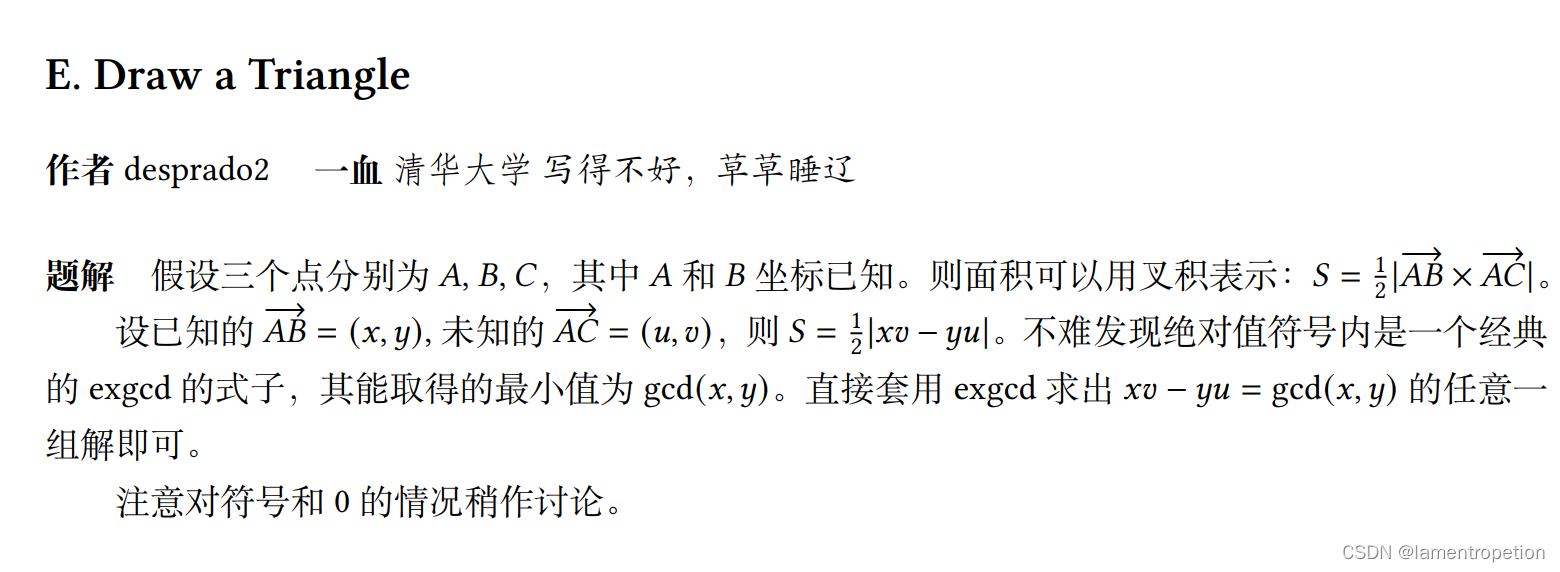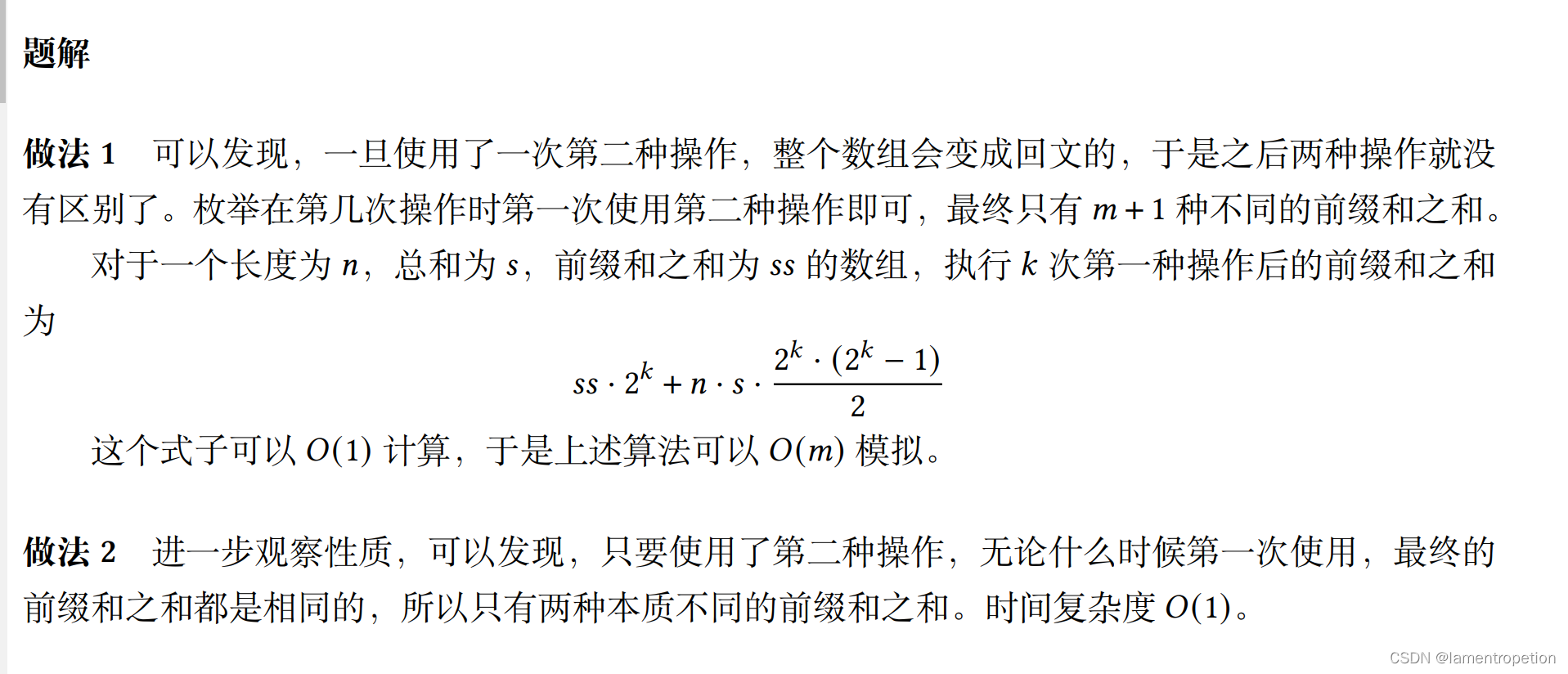A.Lily
Problem - A - Codeforces
题意

思路
数所有周围没L的格子
#include <bits/stdc++.h>using i64 = long long;constexpr int N = 2e5 + 10;
constexpr int mod = 1e9 + 7;
constexpr int Inf = 0x3f3f3f3f;
constexpr double eps = 1e-10;std::string s;int n;void solve() {std::cin >> n >> s;s = " " + s;for (int i = 1; i <= n; i ++) {if (s[i] == 'L') continue;if (i == 1) {if (s[i + 1] != 'L') {s[i] = 'C';}}else if (i == n) {if (s[i - 1] != 'L') {s[i] = 'C';}}else {if (s[i - 1] != 'L' && s[i + 1] != 'L') {s[i] = 'C';}}}std::cout << s.substr(1, n) << "\n";
}
signed main() {std::ios::sync_with_stdio(false);std::cin.tie(nullptr);int t = 1;while(t --) {solve();}return 0;
}M. Youth Finale
Problem - M - Codeforces
题意
给定一个排列,每次可以翻转这个排列,或者循环往左一个单位,给定操作序列,问操作之后给序列做冒泡排序的操作次数
思路
冒泡排序的操作次数其实就是逆序对的对数,那就是求操作之后的逆序对有多少
考虑DS的思想,我们对它的逆序对统计,考虑两次操作对逆序对的贡献
第一种就是逆序对个数 = 长度 - 逆序对个数
对于第二种,考虑操作一下,变化量就是 cur - pre
cur就是原序列中比操作数大的数
pre就是原序列中比操作数小的数
减一下就行
然后发现需要维护操作数,那就拿个 idx 维护即可,发现第一种操作会让方向反向,因此维护 x 方向
#include <bits/stdc++.h>#define int long longusing i64 = long long;#define lowbit(x) (x & (- x))constexpr int N = 1e6 + 10;
constexpr int mod = 1e9 + 7;
constexpr int Inf = 0x3f3f3f3f;
constexpr double eps = 1e-10;std::string s;int n, m;
int p[N];
int tr[N];void add(int x, int k) {for (int i = x; i <= n; i += lowbit(i)) tr[i] += k;
}
int query(int x) {int res = 0;for (int i = x; i; i -= lowbit(i)) res += tr[i];return res;
}
void solve() {std::cin >> n >> m;for (int i = 1; i <= n; i ++) std::cin >> p[i];std::cin >> s;s = " " + s;int cur = 0;for (int i = 1; i <= n; i ++) {cur += query(n) - query(p[i]);add(p[i], 1);}std::cout << cur << "\n";int idx = 1, x = 1;for (int i = 1; i <= m; i ++) {if (s[i] == 'S') {cur = cur - (p[idx] - 1) + (n - (p[idx] + 1) + 1);idx = idx + x;if (idx == n + 1) idx = 1;else if (idx == 0) idx = n;}else {cur = n * (n - 1) / 2 - cur;idx = idx - x;if (idx == 0) idx = n;else if (idx == n + 1) idx = 1;x = -x;}std::cout << cur % 10;}std::cout << "\n";
}
signed main() {std::ios::sync_with_stdio(false);std::cin.tie(nullptr);int t = 1;while(t --) {solve();}return 0;
}E. Draw a triangle
题意

思路

#include <bits/stdc++.h>#define int long longusing i64 = long long;#define lowbit(x) (x & (- x))constexpr int N = 1e6 + 10;
constexpr int mod = 1e9 + 7;
constexpr int Inf = 0x3f3f3f3f;
constexpr double eps = 1e-10;int a, b, c, d;
int v, u;int exgcd(int a, int b, int &v, int &u) {if (!b) {v = 1, u = 0;return a;}int gcd = exgcd(b, a % b, u, v);u -= (a / b) * v;return gcd;
}
void solve() {std::cin >> a >> b >> c >> d;int x = c - a;int y = d - b;int gcd = exgcd(x, -y, v, u);std::cout << a + u << " " << b + v << "\n";
}
signed main() {std::ios::sync_with_stdio(false);std::cin.tie(nullptr);int t = 1;std::cin >> t;while(t --) {solve();}return 0;
}C. Array Concatenation
题意


#include <iostream>
#include <cstdio>
#include <cmath>
using namespace std;
#define int long long
typedef long long lld;
const int N = 100005;
const lld p = 1000000007;
lld sum[N], a[N], tot[N];
lld powe(lld a, lld b) {lld base = 1; while(b) {if(b & 1) base = base * a % p;a = a * a % p; b >>= 1;}return base;
}
lld pos_t = 0, neg_t = 0, squ = 0;
lld ans1 = 0, ans2 = 0;
signed main() {int n, m; scanf("%lld%lld", &n, &m);for(int i = 1; i <= n; i++) {scanf("%lld", &a[i]);squ += a[i]; squ %= p;}for(int i = 1; i <= n; i++) {sum[i] = (sum[i - 1] + a[i]) % p;pos_t = (pos_t + sum[i]) % p;}for(int i = n; i >= 1; i--) {tot[i] = (tot[i + 1] + a[i]) % p;neg_t = (neg_t + tot[i]) % p;}squ = squ * n % p;ans1 = ans2 = squ * powe(2, m - 1) % p * (powe(2, m) - 1 + p) % p; ans1 = (ans1 + powe(2, m - 1) * pos_t % p) % p;ans1 = (ans1 + powe(2, m - 1) * neg_t % p) % p;ans2 = (ans2 + powe(2, m) * pos_t % p) % p;printf("%lld", max(ans1, ans2)); return 0;
}



device_node 转换成 platform_device)
的简单使用)
面试题 17:打印从 1 到最大的 n 位数)






)


)



